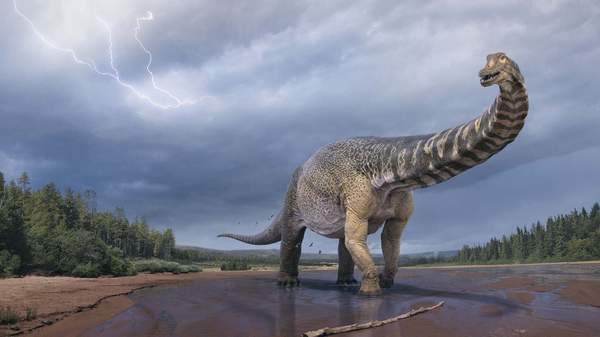Overview
Australia loves its big things. We're home to oversized pineapples, bananas and watermelons, plus lobsters and prawns as well. If you don't pass some kind of giant sculpture while you're road tripping around the country — and stopped to take your picture next to it, of course — your drive just isn't the same. Ever wondered why we're so obsessed with huge items? It seems that we have quite the massive past, too. In fact, the country's largest ever dinosaur has just been officially identified.
Meet Australotitan cooperensis, whose bones where first unearthed in 2007 in Cooper Creek in outback Queensland, but were given an official scientific description and name by palaeontologists from the Eromanga Natural History Museum and Queensland Museum on Monday, June 7. When this huge dino roamed the earth around 95–98 million years ago, it was as long as a basketball court and as tall as a two-storey building. In numbers, that equates to 25–30 metres long, and between five and six-and-a-half metres tall.
Nothing that size or bigger has ever been found on our shores. 'Cooper', as the dino has been nicknamed, is also one of the largest ever discovered worldwide — with dinosaurs of comparable or bigger size only found in South America so far. So, if Jurassic Park or Jurassic World ever happened to become a reality in Queensland, recreating local dinos, we'd all come face to face with quite the mammoth creatures.
Steve Young
"This new titanosaurian is the largest dinosaur from Australia represented by osteological remains," explains Eromanga Natural History Museum and field palaeontologist Robyn Mackenzie. "These are the largest dinosaurs that ever walked on earth and based on the preserved limb size comparisons, this new titnaosaur is estimated to be in the top five largest in the world."
To identify Cooper — and, crucially, to ensure that it was a new species — 3D scans were taken of each bone, which were then compared to those of its closest relatives. That involved cross-referencing with both local species and others worldwide. While Cooper is closely related to three other Australian sauropods that lived during the Cretaceous Period (so, around 92–96 million years ago), this exact dino species hadn't been found before.
If you'd like to see Cooper's fossilised remains, they're on display in the Eromanga Natural History Museum's fossil collection, which is around a 12-hour drive west from Brisbane. The museum has its own onsite place to stay, called Cooper's Country Lodge, should you need somewhere to bunk down for the night.
Further north in Winton, Queensland is already home to a dinosaur-focused museum — because that's where other dinosaur fossils were found back in 1999. So yes, your next road trip can involve trekking across the outback to check out these fascinating remnants of the earth's past. Life finds a way, obviously.
Find the Eromanga Natural History Museum at 1 Dinosaur Drive, Eromanga — open from 9am–5pm daily.
Top image: Eromanga Natural History Museum.
